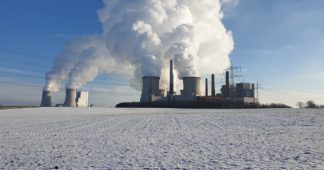If all the announced net-zero commitments are implemented, the global temperature would rise 1.8°C by 2100, policy experts said, adding, “but this is only IF these targets are fully implemented, and it’s a big IF.”
By Julia Conley
Climate policy experts on Tuesday called for the final days of the United Nations Climate Change Conference to be spent with world leaders focusing on closing the “credibility, action, and commitment” gap that has emerged as countries put forward their goals for reaching net-zero fossil fuel emissions, with current targets on track to allow global heating far above the 1.5°C limit.
The climate policy organizations Climate Analytics and NewClimate Institute released their annual Climate Action Tracker (CAT) on Tuesday, showing that even with full implementation of emissions targets set for 2030, the planet is expected to heat up by 2.4°C by the end of the century.
Including implementation of target pledges made in recent days at the U.N. Climate Change Conference (COP26) in Glasgow, Scotland, countries will still be emitting greenhouse gases at twice the rate needed to limit global heating to 1.5°C—falling short of “clear benchmarks” put forth by the Intergovernmental Panel on Climate Change (IPCC).
“To keep the possibility of 1.5°C alive, we need to cut emissions by 45% below 2010 levels by 2030—in other words, halve emissions from present levels by then,” reads the 2021 Climate Action Tracker, subtitled “Glasgow’s 2030 Credibility Gap.”
“The 2020/2021 round of NDCs [nationally determined contributions] updates has only reduced the emissions gap in 2030 by 15 to 17%,” according to the report.
CAT global update: Glasgow has a credibility gap between talk and action. If all govts met their 2030 targets, we would have 2.4˚C of warming in 2100. But right now, current policies put us at 2.7˚C. https://t.co/dkX4jAbo2f
A Thread ? pic.twitter.com/EdLlIfdhXt— ClimateActionTracker (@climateactiontr) November 9, 2021
Coal and gas are the primary drivers of the “appalling outlook” at COP26, according to the CAT.
Coal must be phased out of the power sector by countries in the Organization for Economic Co-operation and Development (OECD) completely by 2030, and worldwide by 2040. But “there is still a huge amount of coal in the pipeline,” according to the report, and many governments are supporting the rise of natural gas—whose main component is methane—as an alternative to coal.
“The biggest of the coal countries, China, India, Indonesia, and Vietnam, must reduce their coal pipelines, but they cannot switch to gas instead,” said Bill Hare, CEO of Climate Analytics. “We cannot let fossil fuels be replaced with more fossil fuels.”
While the 2015 Paris climate agreement called on countries to submit progressively more ambitious targets each time they update their NDCs—the efforts each country agrees to make to draw down their fossil fuel emissions—a number of countries including Australia, Switzerland, and Thailand have resubmitted the same target they announced in 2015, while Brazil and Mexico made even less ambitious commitments.
One hundred and forty countries have now announced or are considering net-zero emissions targets, covering 90% of global emissions, compared to 130 countries which had set targets as of May 2021.
But at COP26, the CAT warned Tuesday, the so-called “‘good news’ of the potential impact of announced net-zero targets was bringing false hope to the reality of the warming resulting from government inaction.”
“If all the announced net-zero commitments or targets under discussion are implemented, this would bring our temperature estimate for this ‘optimistic scenario’ down to 1.8°C by 2100, with peak warming of 1.9°C,” wrote the groups. “But this is only IF these targets are fully implemented, and it’s a big IF. Our analysis, covering 40 countries, shows only 6% of global emissions are covered by targets with an ‘acceptable’ net-zero rating for target comprehensiveness.”
Only three countries—Chile, Costa Rica, and the United Kingdom—and the European Union were given an “acceptable” rating by the CAT for the transparency, scope, and architecture of their net-zero targets. Canada, the U.S., Germany, and South Korea were given “average” ratings while the other nations in the CAT’s 40-country analysis were rated “poor,” did not make enough information available to be rated, or put forward no net-zero target.
“The vast majority of 2030 actions and targets are inconsistent with net-zero goals: there’s a nearly one degree gap between government current policies and their net-zero goals,” said Hare. “It’s all very well for leaders to claim they have a net-zero target, but if they have no plans as to how to get there, and their 2030 targets are as low as so many of them are, then frankly, these net-zero targets are just lip service to real climate action. Glasgow has a serious credibility gap.”
Climate Analytics and NewClimate Institute also found that:
- The projected global warming from current policies—what countries are actually doing—is 2.7˚C, with only a 0.2˚C improvement over the last year and nearly one degree above the net-zero announcements governments have made;
- Since the April 2021 Biden Leaders’ Summit, the CAT’s standard “pledges and targets” scenario temperature estimate of all NDCs and binding long-term targets has dropped by 0.3°C to 2.1°C, primarily due to the inclusion of the U.S. and China’s net-zero targets, now formalized in their long-term strategies submitted to the United Nations Framework Convention on Climate Change;
- Announcements made at COP26 regarding the reduction of methane and coal emissions will “narrow the emissions gap only slightly, if at all”;
- While the projected warming from all net-zero announcements, if fully implemented, is down to 1.8˚C by 2100, this estimate is far from positive news, given the quality of the net-zero goals and the massive ambition and action gap in 2030; and
- This “optimistic” pathway is a long way from the Paris Agreement’s 1.5˚C limit, with peak 21st century warming of 1.9˚C and about a 16% chance of exceeding a warming of 2.4˚C.
Published at www.commondreams.org
We remind our readers that publication of articles on our site does not mean that we agree with what is written. Our policy is to publish anything which we consider of interest, so as to assist our readers in forming their opinions. Sometimes we even publish articles with which we totally disagree, since we believe it is important for our readers to be informed on as wide a spectrum of views as possible.











